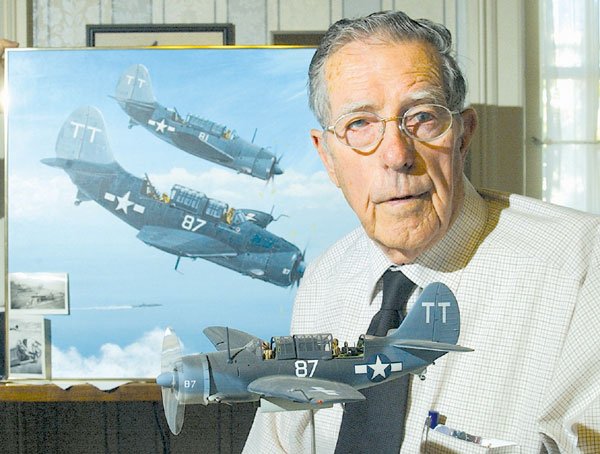Bill Starritt loves America. He always has and he always
will.
He remembers the fury he felt when the Japanese military
devastated the U.S. Naval fleet in Pearl Harbor on Dec. 7,
1941.
Bill Starritt loves America. He always has and he always will.
He remembers the fury he felt when the Japanese military devastated the U.S. Naval fleet in Pearl Harbor on Dec. 7, 1941. The day after, when the recruiting stations of his Mid-West hometown opened, he was among the first in line to sign up for enlistment. Starritt was 17 years old. The U.S. Navy recruiting officer told the eager boy from Ohio to wait until he came of age for military service.
“I enlisted as an aviation cadet,” he said, remembering his strong feeling of patriotic duty to serve.
So many young American men had enlisted and there were so few training posts for aviators that the Navy made Starritt wait about nine months before sending him to Chapel Hill, N.C., for “pre-flight training.”
In that time of anticipation, Starritt attended classes at the University of Virginia. He also met an attractive young woman named Betty whom he fell deeply in love with. Soon after their courtship began, he asked for her hand in marriage.
“We got married by a Justice of the Peace,” he said, thinking about the wedding day.
“No we didn’t,” Betty said, correcting him with a laugh. “It was a Presbyterian minister.”
An annoyed look crossed Starritt’s face as he realized his wife was right.
“Well, whoever it was, we got married.”
Starritt served his country in the Pacific. He didn’t see in any combat, but one of his missions was to drop supplies to captured American servicemen behind the barbed-wire of POW camps in Japan. Flying over the camps, the Japanese guards would shoot at his plane with rifles, then cease when they saw the supplies parachute to the ground.
“It’s about as close as I ever wanted to get to combat,” Starritt said, remembering those perilous missions.
Starritt was on the first U.S. Navy carrier to enter Tokyo Bay at the end of the war.
“I went there with a chip on my shoulder,” he said, recollecting the anger at the Japanese attack on Pearl Harbor and other war-time actions.
But as he came to know the people of the island nation, he found them warm and cordial. The former enemies treated the young American aviator with friendly respect, he recalled.
“They were the most pleasant people to me,” he said.
Returning to America in the post-war years, he and Betty set up a home in Hollister and had three children – Cindy, Mark and Bill Starritt, Jr., who – to avoid confusion with his father – is nicknamed ‘Timer’. A fourth child, a girl named Susan, came later.
Starritt’s patriotic duty – not to mention his love of swift airplanes – helped him decide to stay on for several more years with the Navy Reserves. He was based at the Oakland Air field during his duty time. Later, he started building his gas station business in Hollister.
One day, to give his wife a friendly little greeting, he flew his jet from the Oakland Navy Airfield to Hollister, buzzing the small town by flying low along the main drag of San Benito Street. On that occasion, he barely avoided crashing into the city’s Park Hill near its downtown, Betty said.
“He just shook that town up like you wouldn’t believe,” she said. Starritt’s eyes shined with memories of those days. He fondly recalled flying with his squadron under the Golden Gate Bridge when a thick cloudbank hugged the deck-level of the Golden Gate Bridge, San Francisco’s most famous landmark.
Looking a little bashful as someone brought up the memory, Starritt also described the time he flew under the span of another famous California landmark – Big Sur’s Bixby Bridge on Highway 1. The clearance of this bridge hung far lower than the Golden Gate, and the jagged rocks of the coast jutted up dangerously like cat claws in the surf. The smallest mistake during this daredevil stunt and…
“Betty always reminds me of that whenever we see the bridge on TV,” Starritt said, grinning sheepishly at his wife.
The Korean War began in the late 1940s, and Starritt decided that, with a wife and three children depending on him, it was time he and the Navy parted company. He left the Reserves to focus his attention on building a career and a family.
But the quest for fast-paced escapades still flowed in his veins. Instead of jet planes, Starritt now got his speed fix from fast cars. He’d buy the latest sports car, his daughter Susan Jacobsen said, and often he would challenge high-school boys in dragsters to races along the open country road locals called “the Bolsa” (Highway 25 between Hollister and Gilroy.)
“He loved to race,” she said. “And this 30-year-old man would beat teenagers.”
Betty nodded her head in total agreement.
“He flew fast. He drove fast. He did everything fast.”
During the 1950s, Starritt’s gas stations in Hollister grew popular with the locals. He treated customers well, but his wry sense of humor also brought in patrons.
His daughter Susan Jacobsen showed a reporter the framed newspaper advertisement for Starritt’s Richfield Boron station once located at 250 Tres Pinos Road. The ad, in a 1959 copy of the Hollister Freelance, proclaimed: “FIRE SALE FOR GASOLINE.”
Many of the gas station’s patrons weren’t sure if they wanted gasoline that had “survived” a fire, Starritt said, a twinkle in his eyes. Another portion of the ad boasted the station’s slogan: “Nothing is too good for Bill Starritt’s customers.”
And it wasn’t just the station’s gasoline that gained a reputation for top-quality. Holding a can of motor oil, Starritt made a gesture as if holding a glass of fine wine, and said that, to demonstrate the superiority of his former station’s motor oil, he often drank a glass of it in front of customers.
Despite the station’s popularity, it struggles financially. Starritt’s major business flaw was he was too nice to customers.
“Betty insisted I was the world’s worst collector,” he said. “I don’t like to hassle people for money.”
Starritt said if he happened to see station customers on the street or in local stores, he would try to avoid them so as not to make a scene in public about the past-due bills. He finally let Betty go after the delinquents – and she proved much better at getting the money owed.
In the early 1960s, he decided his career in the gas station business had run its course. Since the end of World War II, the Bay Area’s population boomed as thousands of people moved here for the job opportunities and temperate climate. In 1964, Starritt resolved to become a real estate agent.
“I decided to go to San Jose to learn the real estate business,” he said. “That way, if I failed, no one in Hollister would know about it.”
Starritt did not fail. He found a business he truly felt passionate about. In 1966, he set up his Gilroy office at 7477 Eigleberry Street. He’s remained at the same site ever since. (His sons Bill and Mark would later set up their construction business office next door.) Starritt found satisfaction in helping people find their dream homes – particularly couples just getting started in life.
“And the best thing…” he said, leaving a slight pause for an imaginary drum roll. “The title company does all the collecting for you.”
Betty beamed with a look of pride at her husband.
“He helped a lot of young people get their homes,” she said.
In this age of conglomerate real estate companies where agents in cubicles are often under high competitive pressure to sell, Starritt’s business provides a more relaxed atmosphere. Just like in his old Hollister gas station advertisement, his philosophy is: “Nothing is too good for Bill Starritt’s customers.”
In the past 40 years of helping customers sell and buy their homes, he insists he hasn’t really done a lick of work.
“I enjoy every minute of it,” he said.
His belief: If you love what you do for a living, it will seem more like play than work. And the side-benefit is, you’re almost sure to be a success.
His office walls are filled with memorabilia and photos of family, friends and his time serving his country. On one wall hangs a painted picture of him in his Helldiver which he flew during World War II. It was painted by artist Joe Kline, who works for the City of Gilroy and is well-known in the area for his aviation paintings.
Betty points out a group picture of aviation officers in front of a warplane during the 1940s. Starritt kneels along the bottom row, his confident grin and sharp eyes making him look like a movie star.
“Oh, he was the most handsome man in the Navy,” Betty proclaimed. “He still is handsome.”
Many of the men in the picture are now gone. They were good friends of Starritt’s whom he got to know well during the 20th century’s biggest fight against fascism. Up until three years ago, he and Betty attended the annual reunions to catch up on the latest news with his war buddies. During one reunion, the former airmen took a tour of the Navy’s Top Gun school for its ace pilots.
“The pilots there had the most respect for these old fizzles,” she said, pointing at her husband. “They knew men like Bill really flew by the seat of their pants back then.”
Starritt said nothing for a long moment. The look on his face showed a pride in having served his country and upheld the fight for freedom 60 years ago. On a corner of Starritt’s cluttered desk sits a little cloth doll man in red-white-and-blue colors. It holds an American flag. It’s a simple sign of one man’s love of the United States and its values.
“Can you think of anything to be more proud of?” he asked with the deepest look of sincerity on his face. “It’s still a good country.”















